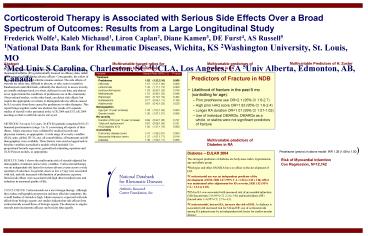Multivariable Predictors of H' Zoster PowerPoint PPT Presentation
1 / 1
Title: Multivariable Predictors of H' Zoster
1
Multivariable Predictors of H. Zoster
Multivariate Predictors of H. Zoster
Corticosteroid Therapy is Associated with Serious
Side Effects Over a Broad Spectrum of Outcomes
Results from a Large Longitudinal Study
Frederick Wolfe1, Kaleb Michaud1, Liron Caplan2,
Diane Kamen3, DE Furst4, AS Russell5 1National
Data Bank for Rheumatic Diseases, Wichita, KS
2Washington University, St. Louis, MO 3Med Univ
S Carolina, Charleston, SC 4UCLA, Los Angeles, CA
5Univ Alberta, Edmonton, AB, Canada
Multivariable hazard ratios for pneumonia
hospitalization.
Multivariable predictors of Fractures in RA
Abstract PURPOSE Studies and meta-analyses
assessing the role of steroids in rheumatoid
arthritis (RA) preferentially focused on efficacy
data, rather than systematically defining adverse
effects. Consequently, the safety of prednisone
in rheumatoid arthritis remains unclear. The side
effects of steroids are often rare, difficult to
discern, or take years to manifest. Randomized
controlled trials, ordinarily the ideal way to
assess toxicity, are usually underpowered, too
short, deficient in cost data, and almost never
approximate the conditions of prednisone use in
the community. Observational studies, on the
other hand, can detect side effects, but require
the appropriate covariates to distinguish adverse
effects caused by RA severity from those caused
by prednisone or other therapies. This report
brings together, under one abstract, the results
of 6 separate studies of steroids risks
presented at the ACR 2004 and EULAR 2004 meetings
so that overall risk can be surveyed. METHODS
For up to 5.6 years, 20,874 RA patients completed
100,113 biannual questionnaires (range 1 to 11)
concerning all aspects of their illness. Major
outcomes were validated by medical records and
physician contacts, as appropriate. A wide range
of severity variables (HAQ, pain, global, SF-36,
etc), all comorbidities, all treatments and all
demographics were available. These factors were
used as lagged and/or baseline variables in
predictive models which included Cox proportional
hazards regression, generalized estimating
equations and GLM Poisson models, as
appropriate. RESULTS Table 1 shows the
multivariate risk of steroids adjusted for
demographic, treatment, and severity variables.
Corticosteroid therapy was an independent risk
factor for serious adverse events across a wide
spectrum of outcomes. In general, doses as low a
5 mg were associated with risk, and risk
increased with duration of prednisone exposure.
Steroid side effects were associated with high
direct medical costs and reduction in measured
quality of life. CONCLUSIONS Corticosteroids
are a not a benign therapy. Although they reduce
radiographic progression and may alleviate
symptoms, the overall burden of steroids is high.
Much concern is expressed with side effects from
biologic agents our studies indicate that side
effects from corticosteroids exceed those of
biologic agents. The decision to employ steroids
must incorporate efficacy and toxicity data
equally.
Multivariable predictors of Diabetes in RA
Prednisone (yes/no) in above model IRR 1.28
(1.09 to 1.50)
- Diabetes EULAR 2004
- The strongest predictors of diabetes are body
mass index, hypertension, age and ethnic group. - Biologics and other DMARDs have no effect on the
development of DM. - Corticosteroid use was an independent predictor
of the development of DM, IRR 1.67 (95 C.I.
1.26 to 2.21). This effect was maintained after
adjustment for RA severity, IRR 1.52 (95 C.I.
1.14 to 2.03). - DM in RA was associated with increased risk of
myocardial infarction (MI) (hazard ratio 3.0 (95
CI 2.3 to 3.9)) and heart failure (HF) (hazard
ratio 3.4 (95 CI 2.7 to 4.3). - Corticosteroids, but not RA, increase the risk of
DM. As diabetes is associated with increased risk
for MI and HF, use of corticosteroids among RA
patients may be an independent risk factor for
cardiovascular disease.
Risk of Myocardial Infarction Cox Regression,
N12,142

